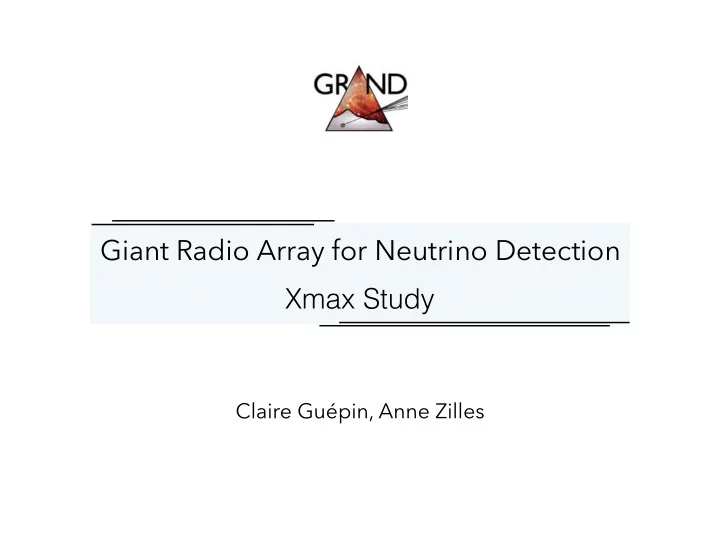

Giant Radio Array for Neutrino Detection Xmax Study Claire Guépin, Anne Zilles
UHECR air showers - Xmax reconstruction From ZHAireS simulations to Xmax reconstruction Inclined UHECR air showers , proton or iron progenitor. • Study impact of • progenitor energy: from 10 17 eV to 10 19 eV. - spacing between antennas: from 250 m to 1250 m. - frequency band : 50 - 200 MHz versus 30 - 80 MHz. - mountain slope: 0º versus 10º. - inclination (zenith). - Strong hypothesis No antenna response (perfect dipole). • Next steps: include antenna response voltage traces with “computevoltage”: ok • noise model and threshold for power : work in progress… •
How to get a radio footprint Simulate the radio signal for 160 antenna positions , which forms a star shape in vxB - vxvxB Get east-west and north-south component → Bandpass filter for 50-200MHz (or 30-80MHz), no antenna model included so far Get the total integrated power for each simulated antenna position Interpolate the power in vxB – vxvxB → rotate antenna positions in shower coordinates and choose power for each position If fake data: Add noise to the “data”
Reconstruction method For each parameter set, 70 simulations (50 proton, 20 iron). One simulation = “fake data” (known Xmax) Simulation set (same properties, known Xmax) Normalized integrated power Comparison
Reconstruction method For each parameter set, 70 simulations (50 proton, 20 iron). One simulation = “fake data” (known Xmax) Simulation set (same properties, known Xmax) Normalized integrated power Comparison Get 𝝍 2 Minimum of parabola fit = reconstructed shower depth
Impact of zenith angle Fixed parameters energy 10 19 eV • azimuth 40º • frequency band : 50 - 200 MHz mountain slope 10º • step 500 m Footprints zenith 72º zenith 77º zenith 83º
Impact of zenith angle Fixed parameters energy 10 19 eV • azimuth 40º • frequency band : 50 - 200 MHz mountain slope 10º • step 500 m Power - lateral distribution function zenith 72º zenith 77º zenith 83º
Impact of zenith angle Fixed parameters energy 10 19 eV • azimuth 40º • frequency band : 50 - 200 MHz mountain slope 10º • step 500 m Chi2 procedure zenith 72º zenith 77º zenith 83º
Impact of zenith angle Fixed parameters energy 10 19 eV • azimuth 40º • frequency band : 50 - 200 MHz mountain slope 10º • step 500 m Histograms zenith 72º zenith 77º zenith 83º 68%: mean Xmax
Impact of zenith angle Fixed parameters energy 10 19 eV • azimuth 40º • frequency band : 50 - 200 MHz mountain slope 10º • 68%: mean Xmax 99% 80 200 zen = 72 o zen = 72 o zen = 77 o zen = 77 o 70 175 zen = 83 o zen = 83 o 60 150 | X reco − X real | (g cm − 2 ) 50 125 | 40 100 − 30 75 | 20 50 10 25 0 0 200 400 600 800 1000 1200 200 400 600 800 1000 1200 Step (m) Step (m)
Impact of mountain slope Fixed parameters zenith 77º • azimuth 40º • frequency band : 50 - 200 MHz energy 10 19 eV • step 500 m slope = 0º slope = 10º
Impact of mountain slope Fixed parameters zenith 77º • azimuth 40º • frequency band : 50 - 200 MHz energy 10 19 eV • slope = 10 o slope = 0 o 60 50 | X reco − X real | (g cm − 2 ) 40 30 20 10 200 400 600 800 1000 1200 Step (m)
Impact of energy and spacing Fixed parameters zenith 83º • azimuth 40º • frequency band : 50 - 200 MHz mountain slope 10º • 68%: mean Xmax 99% 99% 60 180 E = 10 17 eV E = 10 17 eV E = 10 17 . 5 eV E = 10 17 . 5 eV 160 E = 10 18 eV E = 10 18 eV 50 E = 10 18 . 5 eV E = 10 18 . 5 eV 140 E = 10 19 eV E = 10 19 eV | X reco − X real | (g cm − 2 ) 40 120 100 | 30 80 − 20 60 | 40 10 20 0 0 200 400 600 800 1000 1200 200 400 600 800 1000 1200 Distance (m) Step (m) Distance (m) Step (m)
Impact of frequency band Fixed parameters zenith 83º • azimuth 40º • mountain slope 10º • Frequency bands 60 30 - 80 MHz 50 50 - 200 MHz | X reco − X real | (g cm − 2 ) 40 30 20 E = 10 17 eV E = 10 17 . 5 eV 10 E = 10 18 eV E = 10 19 eV 0 500 600 700 800 900 1000 1100 Distance (m)
UHECR air showers - Xmax reconstruction From ZHAireS simulations to Xmax reconstruction Inclined UHECR air showers , proton or iron progenitor. • Study impact of • progenitor energy: from 10 17 eV to 10 19 eV. - spacing between antennas: from 250 m to 1250 m. - frequency band : 50 - 200 MHz versus 30 - 80 MHz. - mountain slope: 0º versus 10º. - inclination (zenith). - Strong hypothesis No antenna response (perfect dipole). • Next steps: include antenna response voltage traces with “computevoltage”: ok • noise model and threshold for power : work in progress… • Questions, discussion?
Recommend
More recommend